Tuesday, December 24, 2019
The Great Smith
Latest item at KSHS opened a window into a bit of history I hadn't heard before. The item is just a gas-tank dipstick, not intrinsically interesting. The description mentions that it was from the Smith Auto Company, based in Topeka.
Was Smith a manufacturer or just a dealer?
Manufacturer. Smith operated from 1902 to 1910. Unlike most carmakers outside the Rust Belt, Smith was NOT just an assembler of off-the-shelf parts. They designed and built their own cars from scratch.
The 'Great Smith' was typical of the period in appearance:
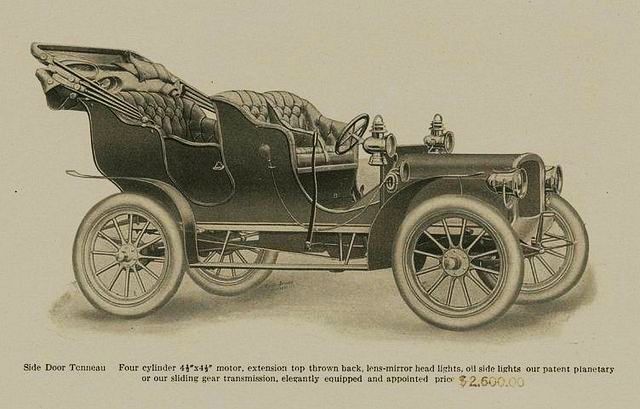 but had several unusual features. The chassis was wood, built something like a railcar:
but had several unusual features. The chassis was wood, built something like a railcar:
 The brake pedal automatically released the clutch. The steering column was telescoping. The throttle pedal was a rocker without a spring. You could push it either way, and it would hold its position.
The brake pedal automatically released the clutch. The steering column was telescoping. The throttle pedal was a rocker without a spring. You could push it either way, and it would hold its position.
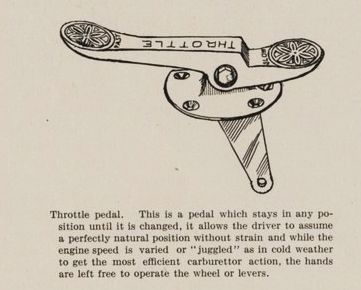 Smith had two transmission options, a planetary version similar to the Ford T, and a unique sliding-gear transmission.**
KSHS has a number of books and catalogs from Smith. The 'Treatise and Catalog', written by Clement Smith, covers the history of autos from 1600, and describes the Smith innovations in loving detail.
Clement and brother Lucius were already successful as makers of medical devices, and the auto business seems to have been a side interest. After inventor Terry Stafford left to start his own company in KC, the Smith car business faded and the brothers continued with trusses and braces and such.
The Smith factory was located at 10th and Jefferson in Topeka, next to the railroad.
Smith had two transmission options, a planetary version similar to the Ford T, and a unique sliding-gear transmission.**
KSHS has a number of books and catalogs from Smith. The 'Treatise and Catalog', written by Clement Smith, covers the history of autos from 1600, and describes the Smith innovations in loving detail.
Clement and brother Lucius were already successful as makers of medical devices, and the auto business seems to have been a side interest. After inventor Terry Stafford left to start his own company in KC, the Smith car business faded and the brothers continued with trusses and braces and such.
The Smith factory was located at 10th and Jefferson in Topeka, next to the railroad.
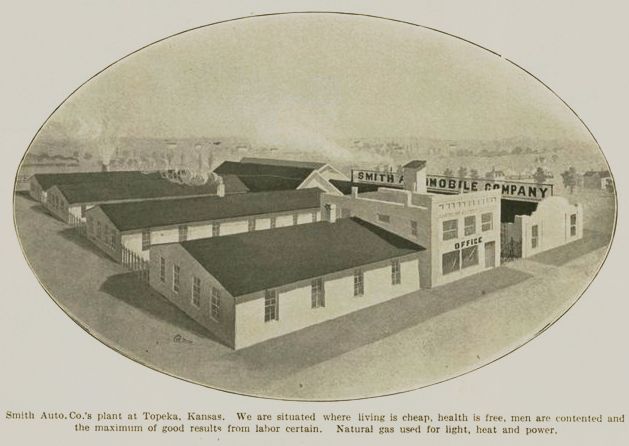 Googlemaps finds the location nicely.
Googlemaps finds the location nicely.
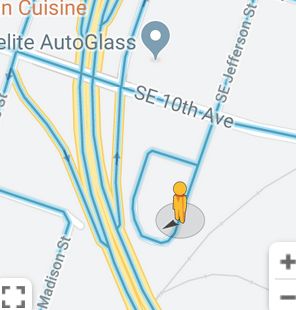 The factory must have been inside the loop. Fortunately Google's camera car went around the loop, which is the sort of place I enjoyed exploring when I was young and foolish. The old narrow street is still there, but the factory is gone.
The factory must have been inside the loop. Fortunately Google's camera car went around the loop, which is the sort of place I enjoyed exploring when I was young and foolish. The old narrow street is still there, but the factory is gone.
 120 years ago this site was humming with invention and innovation.
120 years ago this site was humming with invention and innovation.
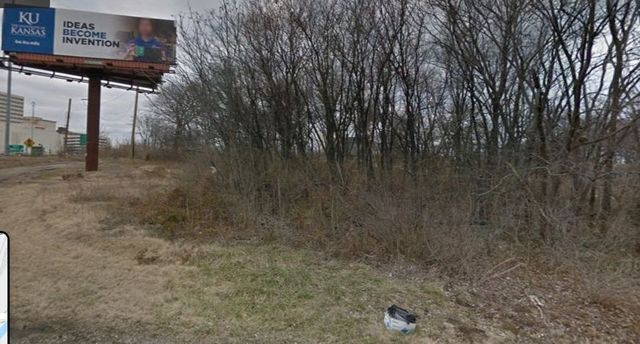 Been there, done that, got the billboard. Nothing else.
= = = = =
Later: A crude 1940 map of Topeka shows a S???? Auto Factory on the north side of 10th and Madison. (Looks more like Stout?)
Been there, done that, got the billboard. Nothing else.
= = = = =
Later: A crude 1940 map of Topeka shows a S???? Auto Factory on the north side of 10th and Madison. (Looks more like Stout?)
 This disagrees with the Smith book, which definitely says 10th and Jefferson, and also disagrees with the drawing of the factory, which clearly has the railroad in the background. The Smith books don't show a map but their description fits where I've put the question mark. My initial assumption of the 'loop' doesn't fit as well.
Current occupants of the 10th and Madison location provide an accidental echo of the original factory:
This disagrees with the Smith book, which definitely says 10th and Jefferson, and also disagrees with the drawing of the factory, which clearly has the railroad in the background. The Smith books don't show a map but their description fits where I've put the question mark. My initial assumption of the 'loop' doesn't fit as well.
Current occupants of the 10th and Madison location provide an accidental echo of the original factory:
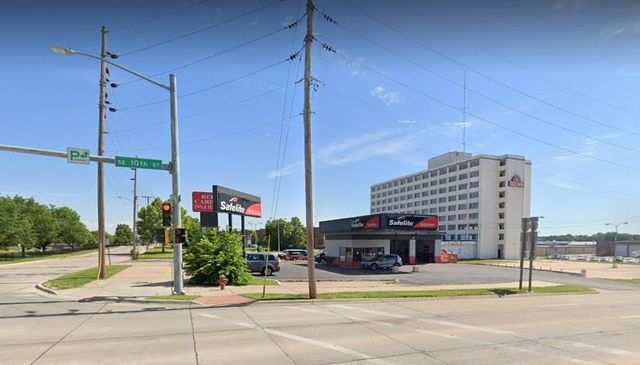 = = = = =
** Footnote on the transmission: It's described fully in patent 830460 by the car's inventor Terry Stafford. It seems to have an automatic clutch and synchromesh, beating GM to the sync by 20 years. Moving the shift lever disengages the clutch, then slides a constant-mesh gear onto a beveled spline, then re-engages the clutch. The 'treatise' claims that you could shift up or down at any speed without touching the clutch pedal, and "without the objectional burr-r-r-r of the gears which is so common in other transmissions." Did it work as claimed? I can't find any road tests in magazines of the time, though they do mention the car and the claim.
Incidentally, this reinforces my rule that all major inventions happened before 1910. Synchromesh joins the list of improvements that supposedly happened later but really happened before 1910.
= = = = =
** Footnote on the transmission: It's described fully in patent 830460 by the car's inventor Terry Stafford. It seems to have an automatic clutch and synchromesh, beating GM to the sync by 20 years. Moving the shift lever disengages the clutch, then slides a constant-mesh gear onto a beveled spline, then re-engages the clutch. The 'treatise' claims that you could shift up or down at any speed without touching the clutch pedal, and "without the objectional burr-r-r-r of the gears which is so common in other transmissions." Did it work as claimed? I can't find any road tests in magazines of the time, though they do mention the car and the claim.
Incidentally, this reinforces my rule that all major inventions happened before 1910. Synchromesh joins the list of improvements that supposedly happened later but really happened before 1910.
 but had several unusual features. The chassis was wood, built something like a railcar:
but had several unusual features. The chassis was wood, built something like a railcar:
 The brake pedal automatically released the clutch. The steering column was telescoping. The throttle pedal was a rocker without a spring. You could push it either way, and it would hold its position.
The brake pedal automatically released the clutch. The steering column was telescoping. The throttle pedal was a rocker without a spring. You could push it either way, and it would hold its position.
 Smith had two transmission options, a planetary version similar to the Ford T, and a unique sliding-gear transmission.**
KSHS has a number of books and catalogs from Smith. The 'Treatise and Catalog', written by Clement Smith, covers the history of autos from 1600, and describes the Smith innovations in loving detail.
Clement and brother Lucius were already successful as makers of medical devices, and the auto business seems to have been a side interest. After inventor Terry Stafford left to start his own company in KC, the Smith car business faded and the brothers continued with trusses and braces and such.
The Smith factory was located at 10th and Jefferson in Topeka, next to the railroad.
Smith had two transmission options, a planetary version similar to the Ford T, and a unique sliding-gear transmission.**
KSHS has a number of books and catalogs from Smith. The 'Treatise and Catalog', written by Clement Smith, covers the history of autos from 1600, and describes the Smith innovations in loving detail.
Clement and brother Lucius were already successful as makers of medical devices, and the auto business seems to have been a side interest. After inventor Terry Stafford left to start his own company in KC, the Smith car business faded and the brothers continued with trusses and braces and such.
The Smith factory was located at 10th and Jefferson in Topeka, next to the railroad.
 Googlemaps finds the location nicely.
Googlemaps finds the location nicely.
 The factory must have been inside the loop. Fortunately Google's camera car went around the loop, which is the sort of place I enjoyed exploring when I was young and foolish. The old narrow street is still there, but the factory is gone.
The factory must have been inside the loop. Fortunately Google's camera car went around the loop, which is the sort of place I enjoyed exploring when I was young and foolish. The old narrow street is still there, but the factory is gone.
 120 years ago this site was humming with invention and innovation.
120 years ago this site was humming with invention and innovation.
 Been there, done that, got the billboard. Nothing else.
= = = = =
Later: A crude 1940 map of Topeka shows a S???? Auto Factory on the north side of 10th and Madison. (Looks more like Stout?)
Been there, done that, got the billboard. Nothing else.
= = = = =
Later: A crude 1940 map of Topeka shows a S???? Auto Factory on the north side of 10th and Madison. (Looks more like Stout?)
 This disagrees with the Smith book, which definitely says 10th and Jefferson, and also disagrees with the drawing of the factory, which clearly has the railroad in the background. The Smith books don't show a map but their description fits where I've put the question mark. My initial assumption of the 'loop' doesn't fit as well.
Current occupants of the 10th and Madison location provide an accidental echo of the original factory:
This disagrees with the Smith book, which definitely says 10th and Jefferson, and also disagrees with the drawing of the factory, which clearly has the railroad in the background. The Smith books don't show a map but their description fits where I've put the question mark. My initial assumption of the 'loop' doesn't fit as well.
Current occupants of the 10th and Madison location provide an accidental echo of the original factory:
 = = = = =
** Footnote on the transmission: It's described fully in patent 830460 by the car's inventor Terry Stafford. It seems to have an automatic clutch and synchromesh, beating GM to the sync by 20 years. Moving the shift lever disengages the clutch, then slides a constant-mesh gear onto a beveled spline, then re-engages the clutch. The 'treatise' claims that you could shift up or down at any speed without touching the clutch pedal, and "without the objectional burr-r-r-r of the gears which is so common in other transmissions." Did it work as claimed? I can't find any road tests in magazines of the time, though they do mention the car and the claim.
Incidentally, this reinforces my rule that all major inventions happened before 1910. Synchromesh joins the list of improvements that supposedly happened later but really happened before 1910.
= = = = =
** Footnote on the transmission: It's described fully in patent 830460 by the car's inventor Terry Stafford. It seems to have an automatic clutch and synchromesh, beating GM to the sync by 20 years. Moving the shift lever disengages the clutch, then slides a constant-mesh gear onto a beveled spline, then re-engages the clutch. The 'treatise' claims that you could shift up or down at any speed without touching the clutch pedal, and "without the objectional burr-r-r-r of the gears which is so common in other transmissions." Did it work as claimed? I can't find any road tests in magazines of the time, though they do mention the car and the claim.
Incidentally, this reinforces my rule that all major inventions happened before 1910. Synchromesh joins the list of improvements that supposedly happened later but really happened before 1910.Labels: 1901
